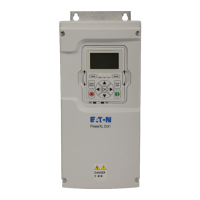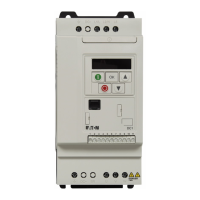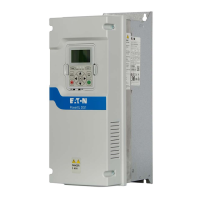10
Modbus RTU On-Board communications
POWERXL DG1 SERIES VFD MN040010EN—September 2016 www.eaton.com
The function code field of a message frame contains two
characters (ASCII) or eight bits (RTU). Valid codes are in the
range of 1–255 decimal. When a message is sent from a
master to a slave device, the function code field tells the
slave what kind of action to perform.
Examples are to read the ON/OFF states of a group of
discrete coils or inputs; to read the data contents of a group
of registers; to read the diagnostic status of the slave; to
write to designated coils or registers; or to allow loading,
recording or verifying the program within the slave.
When the slave responds to the master, it uses the function
code field to indicate either a normal (error-free) response
or that some kind of error occurred (called an exception
response). For a normal response, the slave simply echoes
the original function code. For an exception response,
the slave returns a code that is equivalent to the original
function code with its most significant bit set to a logic
state of 1.
The data field is constructed using sets of two hexadecimal
digits, in the range of 00 to FF hexadecimal. These
can be made from a pair of ASCII characters, or from
one RTU character, according to the network’s serial
transmissionmode.
The data field of messages sent from a master to slave
devices contains additional information that the slave must
use to take the action defined by the function code. This
can include items like discrete and register addresses, the
quantity of items to be handled, and the count of actual
data bytes in the field.
If no error occurs, the data field of a response from a
slave to a master contains the data requested. If an error
occurs, the field contains an exception code that the
master application can use to determine the next action
tobetaken.
Two kinds of checksum are used for standard Modbus
networks. The error checking field contents depend upon
the transmission method that is being used.
Supported functions
Table 8. Functions
Function code Description
0x01
Read coils
0x02
Read discrete inputs
0x03
Read holding registers
0x04
Read input registers
0x05
Write single coil
0x06
Write single register
0x07
Read exception status
0x08
Read diagnostics
(Only support 0x00 return query data)
0x0F
Write multiple coils
0x10
Write multiple registers
0x17
Read/write multiple registers
0x2B/0x0E
Read device identity
ote:N Note: Broadcasting can be used with codes 0x05,
0x06, 0x0F and 0x10.
Example of the request to read coils 2000–2003 from Slave
device 18.
Table 9. Request to read coils
Item Code Description
Slave address 0x12
Function code 0x01
Start address High 0x07
Starting address 0x07D0 hex (= 2000)
Start address Low 0xD0
Number of coils High 0x00
Number of coils 0x0003 hex (= 3)
Number of coils Low 0x03
CRC High 0x7E
CRC Low 0x25

